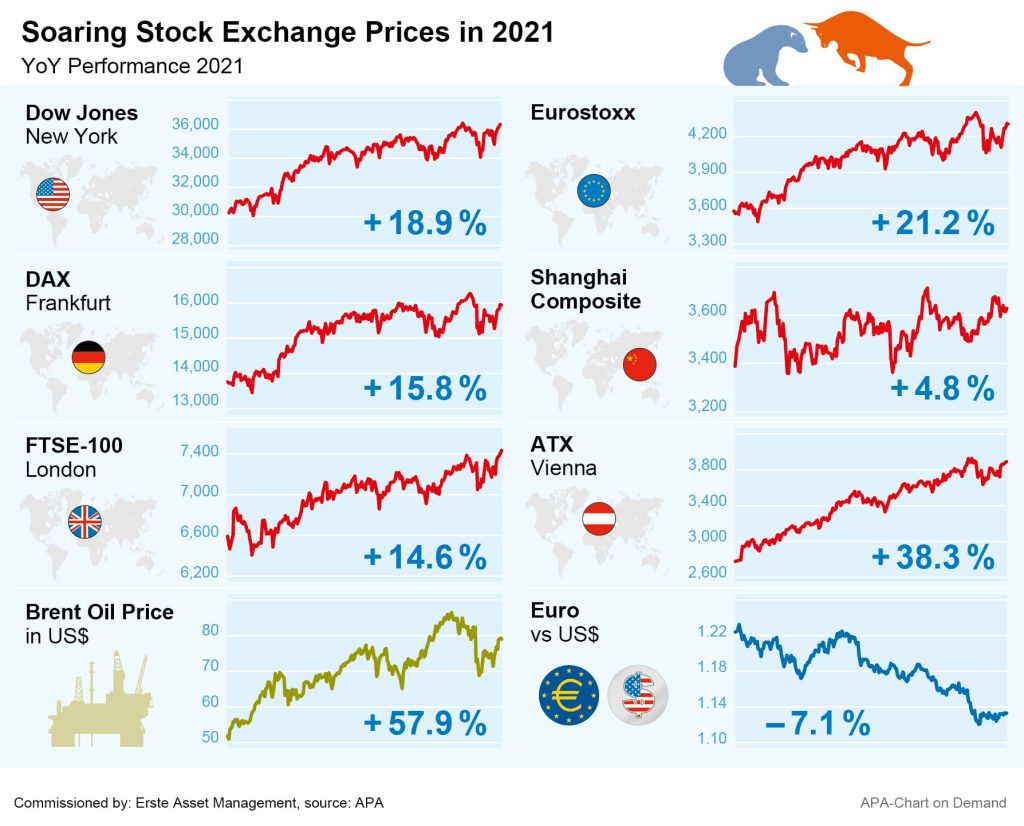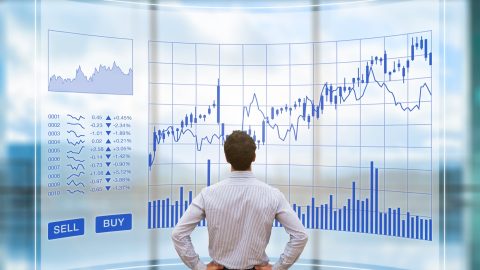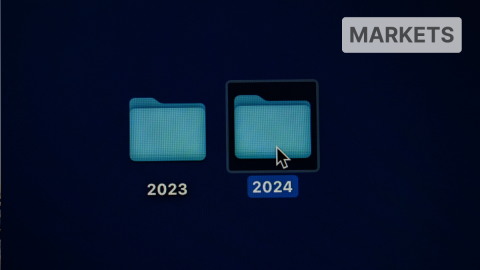For the world’s stock markets, the second year of the coronavirus pandemic ended with partly spectacular gains. The US stock markets, for example, closed near their most recent record highs. The Dow Jones gained almost 19 per cent over the course of the year, while the S&P-500 recovered around 27 per cent in 2021. European stock markets also saw a significant upward trend, with the Euro Stoxx 50 closing out the year on a strong 21 per cent gain. The German DAX (up 16 per cent) and the British FTSE (up 15 per cent) also posted significant gains. Vienna saw even stronger gains, with the ATX one of the best-performing indices in Europe, up 38 per cent.
Gains in China were somewhat weaker, with the Shanghai Composite gaining just under 5 per cent in the past year. China was held back by, among other things, temporary power shortages, production stoppages and a real estate crisis resulting from the the highly indebted Immo Group Evergrande’s payment difficulties.

Performance of selected stock indices frpm 2017 to 2021 in %
| Index | 2021 | 2020 | 2019 | 2018 | 2017 |
| Dow Jones | 18,9 | 9,7 | 25,3 | -3,5 | 28,1 |
| Eurostoxx | 21,2 | -2,6 | 29,3 | -11,3 | 10,1 |
| DAX | 15,8 | 3,6 | 25,5 | -18,3 | 12,5 |
| FTSE-100 | 14,6 | -11,6 | 17,3 | -8,7 | 11,9 |
| Shanghai Composite | 4,8 | 13,9 | 22,3 | -24,6 | 6,6 |
| ATX | 38,3 | -10,8 | 20,5 | -17,4 | 34 |
Source: Refinitiv Eikon Datastream
Economy Showed Significant Recovery in 2021
Global stock market prices were driven by the economic recovery following the year-long crisis of 2020, with the US gross domestic product growing by 2.3 per cent in Q3 on an annualized basis – in Q2, the GDP showed even stronger growth of 6.7 per cent. Whilethe US economy slumped by 3.4 per cent in the first pandemic year of 2020, economists now expect the GDP to increase by well over 5 per cent for the entire year, which would be the fastest growth since 1984. The economy in the euro zone has also recovered significantly: euro zone GDP climbed 2.2 per cent quarter-on-quarter from July to September, with 2.2 per cent growth in the euro zone in Q2.
However, many sectors continue to be held back by high energy prices and supply chain problems. Demand for many products, which rose sharply with the recovery, was offset by raw material and intermediate product bottlenecks, as the lockdowns resulted in production cutbacks and even plant shutdowns. Notably, shortages of computer chips have been particularly severe. Strong demand for technology in times of lockdowns and home office work have caused demand for chips to spike unexpectedly. In particular, the recent upturn in car manufacture has led to a shortage of direly needed chips. Despite full order books, assembly lines ground to a halt at times.
Rapid Energy Price Rises Fuel Inflation and Interest Rate Fears
In line with the economic upturn and the resulting stronger demand for energy, energy prices soared in 2021. At the turn of the year, the price of Brent crude oil was quoted at just under 80 dollars, an increase of around 58 per cent since the beginning of the year.
The increase in natural gas prices proved to be even stronger, where a sharp rise in demand – above all from China – met with production shortfalls and thus a supply shortage. The gas price increases and a growing electricity demand as the economy recovered subsequently led to the demand shifting to coal, again resulting in rising prices. According to the International Energy Agency (IEA), global electricity generation from coal is expected to reach a record level this year.
The energy price increases and supply chain problems are markedly reflected in inflation statistics. Inflation in the euro zone rose to 4.9 per cent in November, the highest level since the start of the survey in 1997, more than double the European Central Bank’s target of 2 per cent annual inflation. In the US, the most recent increase was even stronger, with goods and services costing 6.8 per cent more in November than in the previous year. This is the highest value since 1982.
With the high inflation rates, fears of counteracting interest rate increases by the central banks and thus an imminent end to the loose monetary policy supporting the economy are also increasing on the stock exchanges. The Bank of England already initiated the turnaround in interest rates in December, surprisingly raising its key rate from 0.1 to 0.25 per cent.
Central Banks are Exiting Crisis Mode
The US Federal Reserve has also recently began to end its crisis mode. Starting in January, the reduction of stimulus purchases is to be accelerated, and in March, the economic boosts are to be discontinued completely. The Fed recently signaled several interest rate hikes for 2022. Fed Chairman Jerome Powell made it clear that the economy no longer needs the aid and that the days of cheap money will soon be numbered: given high inflation and rapid progress in the labour market, he said that the Fed is “very, very well positioned for rate hikes.” A number indicators of consumer sentiment and consumer confidence in the US also recently corroborate this with surprisingly sharp upward trends.
Euro Weakened Against the Dollar in 2021
The European Central Bank also plans to end bond purchases under its emergency coronavirus pandemic PEPP program in late March, but the ECB is unlikely to raise its record-low key interest rate of 0.0 per cent for the time being. According to the central bank’s assessment, inflation is likely to remain high for the time being, but overall it is likely to remain a temporary phenomenon.
The expectation of an accelerated monetary tightening policy in the US was also reflected on the foreign exchange market in the past year. The prospect of higher US interest rates supported the US dollar, resulting in the euro returning from around USD 1.20 at the outset of the year to USD 1.13 at the year’s conclusion.
Economic Recovery Expected to Continue in 2022
The bottom line, however, is that the economic recovery is likely to continue in 2022, albeit at a slower pace. For example, the ECB recently lowered its forecast for GDP growth in the euro zone from 4.6 to 4.2 per cent, with the coronavirus omicron variant’s rapid spread causing uncertainty at the end of the year. Although the latest reports indicate a milder progression compared with the delta variant, this is offset by high infection figures, which could once more lead to stronger containment measures. Finally, the tensions between Russia and the Ukraine are also being closely followed in Europe and the United States, while advancing digitalization and the fight against climate change are likely to remain a defining issue as well.
CONCLUSION: The stock market returns of 2021 were largely brilliant. The Vienna Stock Exchange shone with a top performance in Europe. The economic recovery is expected to continue in 2022, possibly not at the pace of the previous year. The pandemic and political tensions remain risk factors.
Legal note:
Prognoses are no reliable indicator for future performance.
Legal disclaimer
This document is an advertisement. Unless indicated otherwise, source: Erste Asset Management GmbH. The language of communication of the sales offices is German and the languages of communication of the Management Company also include English.
The prospectus for UCITS funds (including any amendments) is prepared and published in accordance with the provisions of the InvFG 2011 as amended. Information for Investors pursuant to § 21 AIFMG is prepared for the alternative investment funds (AIF) administered by Erste Asset Management GmbH pursuant to the provisions of the AIFMG in conjunction with the InvFG 2011.
The currently valid versions of the prospectus, the Information for Investors pursuant to § 21 AIFMG, and the key information document can be found on the website www.erste-am.com under “Mandatory publications” and can be obtained free of charge by interested investors at the offices of the Management Company and at the offices of the depositary bank. The exact date of the most recent publication of the prospectus, the languages in which the key information document is available, and any other locations where the documents can be obtained are indicated on the website www.erste-am.com. A summary of the investor rights is available in German and English on the website www.erste-am.com/investor-rights and can also be obtained from the Management Company.
The Management Company can decide to suspend the provisions it has taken for the sale of unit certificates in other countries in accordance with the regulatory requirements.
Note: You are about to purchase a product that may be difficult to understand. We recommend that you read the indicated fund documents before making an investment decision. In addition to the locations listed above, you can obtain these documents free of charge at the offices of the referring Sparkassen bank and the offices of Erste Bank der oesterreichischen Sparkassen AG. You can also access these documents electronically at www.erste-am.com.
N.B.: The performance scenarios listed in the key information document are based on a calculation method that is specified in an EU regulation. The future market development cannot be accurately predicted. The depicted performance scenarios merely present potential earnings, but are based on the earnings in the recent past. The actual earnings may be lower than indicated. Our analyses and conclusions are general in nature and do not take into account the individual characteristics of our investors in terms of earnings, taxation, experience and knowledge, investment objective, financial position, capacity for loss, and risk tolerance.
Please note: Past performance is not a reliable indicator of the future performance of a fund. Investments in securities entail risks in addition to the opportunities presented here. The value of units and their earnings can rise and fall. Changes in exchange rates can also have a positive or negative effect on the value of an investment. For this reason, you may receive less than your originally invested amount when you redeem your units. Persons who are interested in purchasing units in investment funds are advised to read the current fund prospectus(es) and the Information for Investors pursuant to § 21 AIFMG, especially the risk notices they contain, before making an investment decision. If the fund currency is different than the investor’s home currency, changes in the relevant exchange rate can positively or negatively influence the value of the investment and the amount of the costs associated with the fund in the home currency.
We are not permitted to directly or indirectly offer, sell, transfer, or deliver this financial product to natural or legal persons whose place of residence or domicile is located in a country where this is legally prohibited. In this case, we may not provide any product information, either.
Please consult the corresponding information in the fund prospectus and the Information for Investors pursuant to § 21 AIFMG for restrictions on the sale of the fund to American or Russian citizens.
It is expressly noted that this communication does not provide any investment recommendations, but only expresses our current market assessment. Thus, this communication is not a substitute for investment advice, does not take into account the legal regulations aimed at promoting the independence of financial analyses, and is not subject to a prohibition on trading following the distribution of financial analyses.
This document does not represent a sales activity of the Management Company and therefore may not be construed as an offer for the purchase or sale of financial or investment instruments.
Erste Asset Management GmbH is affiliated with the referring Sparkassen banks and Erste Bank.
Please also read the “Information about us and our securities services” published by your bank.
Subject to misprints and errors.




